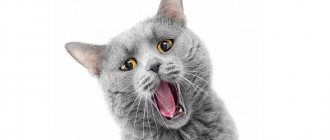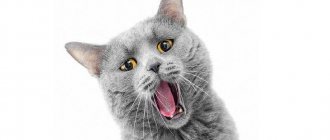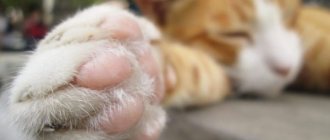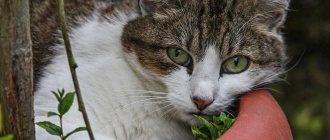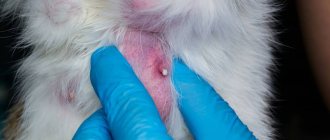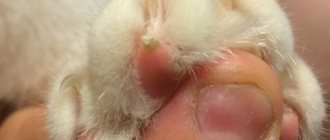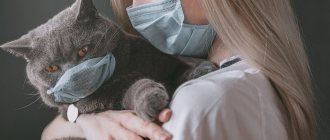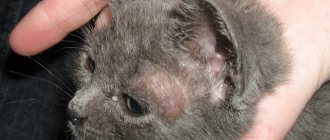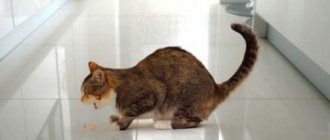Coughing is a protective reaction of the cat’s body from foreign objects that enter the respiratory tract, esophagus or stomach. Coughing can also be caused by hairballs in the stomach, inflammatory processes in the respiratory system, attacks of allergies or bronchial asthma.
If the owner notices that the cat is choking and coughing, as if it has choked, immediate measures must be taken to save the animal from suffocation. Let's find out why a cough occurs and how to independently help your pet before the veterinarian arrives.
Mechanism of cough development
A periodically occurring cough in a cat may indicate the development of inflammatory processes in the respiratory system, which require long-term treatment under the supervision of a veterinarian. It can also occur when trying to get rid of hairballs that accumulate in the animal’s stomach.
However, if the cat spontaneously begins to cough, wheeze, stretch out and press itself to the floor, this most often indicates ingestion or inhalation of small foreign objects. In this case, the animal must be quickly assisted or taken to the clinic without delay.
A cough is a strong, accelerated exhalation through the mouth, which occurs due to a sharp contraction of the muscles of the respiratory tract as a result of irritation of the receptors. In this way, the cat's respiratory tract is freed from mechanical substances that impede the movement of air along the airways.
The cough algorithm consists of the following stages:
- take a deep breath for no more than 2 seconds;
- reflex contraction of the smooth muscles of the larynx, which closes the glottis;
- increased tone of the bronchial muscles;
- sharp contraction of the abdominal muscles;
- opening of the glottis;
- a powerful exhalation that expels foreign agents.
Types and symptoms of cough in cats
The classification of cough in cats is described in detail in the table.
| Characteristics of cough | Degrees and types of cough manifestations |
| Force | slight cough; hacking cough |
| Form depending on duration | acute (less than 14 days); prolonged (from 14 to 45 days); chronic |
| Timbre | silent; voiced; deaf; hoarse; hoarse; barking |
| Presence of discharge | dry; wet |
| Character of sputum | serous; slimy; purulent; mixed with blood |
| Development time | constant; seasonal |
Symptoms that most often accompany coughing in cats include:
- discharge from the nasal cavity;
- vomit;
- wheezing.
The nature of the cough helps specialists make the correct diagnosis, identify the causes and prescribe appropriate treatment for a coughing cat.
Stretching for defense and attack
There are also fundamental tactics for self-defense against possible predators and for hunting prey. Stretching lengthens muscle fibers to their full extent. This preserves and enhances the cat's ability to attack if necessary. In addition, a cat's ability to remain motionless for several hours allows it to prepare its body to attack at any moment.
Every time you think that all cats are lazy, looking at a relaxed animal stretching, remember, at such a moment she thinks: I have everything under control here, I can relax. And the display of teeth that accompanies a yawn can mean: see, my fangs are quite large, don’t even try to throw anything away!
Main causes of cough in cats
Veterinary experts identify 6 main causes of cough in cats.
- Bronchial asthma. This is one of the types of allergies that occur in a cat to foreign components that can be contained in dust, pollen, hair from other pets, dead particles of human skin, as well as in medications and chemicals.
- The presence of foreign objects in the upper respiratory tract, esophagus or stomach.
- Pathologies of the cardiovascular system.
- Helminthic infestations. During migration, Toxocara larvae enter the lungs. This most often occurs in young animals due to untimely deworming after weaning. In this case, the kitten coughs heavily and may vomit a foamy mass in which parasites are found. The cat may also cough constantly due to the presence of heartworms in the pulmonary arteries. These thin, long helminths parasitize the heart, pulmonary artery and small capillaries. They clog blood vessels, which causes frequent severe coughing, vomiting, shortness of breath, loss of appetite, and in case of severe infestation, convulsions and death.
- Infectious diseases of the upper respiratory tract. The most common diseases include herpes, rhinotracheitis and calicivirus.
- Pneumonia. The etiological factors for the occurrence of pneumonia in cats are pathogenic bacteria, viruses, microscopic fungi, as well as external factors such as hypothermia, eating cold food, and keeping the animal in unsanitary conditions.
- Malignant tumors in the respiratory organs.
Important! Among infectious agents, a special place is occupied by the pathogenic bacterium Bordetella bronchiseptica, which causes bordetellosis. Most often, this disease is transmitted by airborne droplets when cats are kept in crowded conditions in nurseries. The infection is also spread by stray cats, which can infect free-roaming pets.
If the cat is coughing heavily and breathing heavily, then the cause of this condition may be pneumo- or hydrothorax, caused by the penetration of air or liquid into the chest cavity.
Diagnosis of the condition
The multiplicity of causes that can cause cat cough makes it very difficult to diagnose cats. Therefore, the veterinary specialist consistently conducts a series of studies, including:
- collection of anamnestic data;
- inspection;
- palpation;
- percussion;
- auscultation;
- general and clinical blood test;
- radiography;
- coprogram for identifying intestinal helminth eggs.
If it is not immediately possible to determine the reason why the cat cannot cough, the veterinarian will prescribe additional laboratory and instrumental tests.
Note! Only large veterinary clinics can afford additional research, and the cost of these services is quite high. Therefore, it is advisable to carry them out more often for such high-pedigreed “expensive” cats as Sphynx, Maine Coon, Peterbald, Scottish Fold and others.
Specific additional studies that will help determine exactly why a cat is coughing with wheezing include:
- sputum analysis for the presence of viral agents and their identification;
- fluoroscopy of the esophagus using a contrast indicator;
- endoscopy of the upper respiratory tract and esophagus;
- bronchoalveolar lavage (performed under general anesthesia).
If the doctor suspects that the cat cannot cough due to the development of pathology of the cardiovascular system, the doctor will prescribe an ECG or ultrasound of the heart.
How to treat cat cough
If a cat is coughing, it can be treated at home only after being examined at a veterinary clinic, making an accurate diagnosis and prescribing appropriate therapy.
You should not self-administer cough suppressants before visiting a doctor, as this may change the clinical picture of the disease and make it difficult to determine the cause of the pathology.
Important! If the cat is coughing and wheezing, as if he is choking, then you should not take any independent action. It is better to quickly take your pet to the hospital or call a doctor at home. Delay can also be fatal when the cat wheezes, trying to burp, but only spits up saliva or foamy liquid.
If a cat coughs due to an infectious disease of viral etiology, the doctor prescribes:
- antibacterial drugs (Amoxisan, Sinulox, Tsiprovet) to prevent the development of secondary bacterial infections;
- mucolytic and expectorants (Bromhexine, licorice extract);
- immunomodulators (Cycloferon, Fosprenil, Maxidin);
- globulin Vitafel;
- intravenous injections of Ringer-Locke solution or saline with 5% glucose (to prevent dehydration when refusing food).
If the cough is accompanied by wheezing and the cat coughs while stretching its neck, then the cause may be pneumonia or another inflammatory process in the respiratory system. In this case, antibiotics are first prescribed. And to relieve coughing, the cat should be given antispasmodics, mucolytics and expectorants.
If a cat's cough is accompanied by vomiting, this often indicates helminthiasis. In this case, anthelmintic drugs are prescribed (Pyrantel, Prazicide, Drontal, Milbemax). Despite the fact that these medications are sold in pharmacies without a prescription, you should not use them yourself if your cat wheezes and tries to burp.
In case of severe infestation, an incorrectly selected dosage can lead to excessive activity of parasites and lead to suffocation. Illiterate actions by owners can also lead to intestinal rupture or excessive intoxication in small kittens.
If the reason that the cat is coughing and stretching its neck, as if choking, is trichobezoars, then the doctor will prescribe special pastes and gels to remove or dissolve hairballs in the stomach.
If a cat coughs and wheezes with its tongue hanging out, this may indicate an attack of bronchial asthma. You can quickly relieve an attack with:
- glucocorticosteroids (Hydrocortisone, Prednisolone, Dexamethasone, Fluocinolone);
- bronchodilators (Theophylline, Atropine);
- antibiotics (if there is a threat of infection by pathogenic bacteria).
Important! Self-administration of glucocorticosteroid and bronchodilator drugs to treat Sphynxes and other cats when they cough while stretching their necks can lead to overdose, complications and the development of side effects. Therefore, you should not put your pet’s life at risk; you must urgently take him to the clinic.
The reason that the cat is coughing, wheezing, as if he is choking, may be a heart attack, which develops in the cat as a result of a hidden pathology of the cardiovascular system. In this case, any independent treatment is unacceptable.
You should immediately call the clinic, call a veterinary specialist to your home and get a recommendation on the actions that need to be taken before his arrival.
What does a cat stretch its paws up?
Cat body language and how to understand what a cat wants to say
Observing the behavior of pets is a fascinating activity. By carefully studying their habits, body movements and postures, you can determine what the animal is trying to say.
A cat communicates with a person not only through vocal sounds, but also through body language.
Tail Signs The tail is the most powerful indicator of a pet's condition. It can be considered a kind of mood indicator. What can he talk about?
If the cat is irritated or interested in something, it will wave the tip of its tail from side to side. Such twitching indicates a slight degree of irritation, which can develop into an aggressive manifestation of dissatisfaction.
When a cat flicks its tail sharply up and down, it is showing strong excitement and anxiety. His hair stands on end and he becomes fluffy. She gets very angry and is ready to attack. In this state, it is better to leave the animal alone.
Depression and a state of fear are characterized by a tail clamped between the legs. In order for the cat to calm down, it is necessary to eliminate the source of danger.
A raised tail with a straightened or slightly curved tip expresses the joyful state of a pet. Conversely, a drooping tail shows the animal is tired or disappointed.
If the tail trembles, it means the animal is marking its territory.
Another simpler pattern of tail signs in cats.
Gaze The visual organ reflects well the mood of the cat. If the pet is in a calm mood and does not feel danger, then its eyes will be closed or half-closed. This is how he expresses his trust.
A cat shows curiosity through wide open eyes. So she studies the world around her with interest. But there is another meaning. An open gaze can indicate fear or aggression. In this way she tries to scare the enemy. Most often, this look can be found in fighting cats.
Cats do not like direct and long eye contact. They perceive this behavior as a challenge.
Ear positions Ears are no less informative. There are a number of emotions that are expressed through the position of the ears. For example, ears pressed to the head indicate the animal’s aggressiveness and readiness to attack. Twitching in the direction from the eyebrows to the back of the head expresses his excitement.
A cat's playful state or desire to hunt can be determined by its forward-pointing ears. An upright position signifies interest in things around you.
Paw Movements Trampling or moving the paws means that the pet is happy and satisfied. If the cat is alert, it will freeze with its front paw raised.
When an animal lacks attention or affection, it will touch the owner with its paw.
Squatting on the front legs means an aggressive attitude and readiness to attack. Squatting on its hind legs may indicate confusion in your pet.
Body movements A cat shows its affection and trust in its owner through friction against a person’s leg. This behavior indicates a relaxed state of the animal, which is begging for something, for example, affection. She also tries to leave her scent on a person as a sign of affection.
How to understand that a cat is not just coughing, but choking
If a cat coughs, wheezes and at the same time stretches out, pressing her whole body to the floor, then in 99% of cases this indicates that a foreign object has entered the esophagus or respiratory tract. When a cat coughs as if he is choking, you should not do anything on your own. You should immediately take your pet to the clinic.
Sometimes the cat gags and coughs, as if he wants to vomit, but attempts remain to no avail. This may indicate that the pet is unable to get rid of a large trichobezoar in the stomach on its own.
If the cat coughed, as if she was choking, but quickly came to her senses, then there is no reason to worry, as she could simply have choked.
Stretching like gymnastics
As already mentioned, cats are able to remain motionless for several hours. In fact, cats typically sleep 12 to 16 hours a day—more than almost all mammals and twice as much as humans. Therefore, just like you and me, cats need to stimulate blood circulation in the body as soon as they come out of sleep. Anatomy researchers at the Royal Veterinary College in London have suggested that cats simply stretch when they feel good, thereby increasing the flow of blood throughout the body.
How to help a cat who is choking
If, after eating fish or tubular bones, the cat sticks out its tongue, coughs, wheezes, or simply sits with its mouth slightly open, then there is a high probability that a sharp bone is stuck in its throat or esophagus.
If you have experience with animals, you can try to remove it yourself. But this can only be done if the bone is clearly visible in the oral cavity. To do this, you need to secure the cat. Then ask an assistant to hold the animal and try to open the pet's mouth wide.
The next step is to remove the bone using tweezers.
If the cat coughs, wheezes, or sticks out its tongue and makes wheezing sounds, but upon examination a foreign object cannot be detected, then the animal should be taken to the doctor immediately.
Facial expressions and gestures of cats
Another way of communication is body language. The facial expressions of cats are very expressive, so it will not be difficult for an attentive owner to understand the mood of the pet by the position of the ears or the expression of the eyes. There are also a number of specific poses that express the feelings of the animal at one time or another. Cats use almost all parts of their body to express emotions.
The eyes of a domestic cat are a unique visual device that allows the pet to see perfectly and accurately estimate the distance to objects. In addition, they are able to convey a whole range of feelings. If the eyes are wide open, this means that the animal is preoccupied or interested in what is happening. Half-closed eyes are a sign of relaxation and tranquility of the cat, while squinted eyes express a challenge. Looking straight ahead and concentrating on an object is a signal that the cat is aggressive.
The ears are part of the cat’s hearing organ, which is superbly developed in these animals. Cats can perceive sound waves over a wide range, including ultrasound. This helps them when hunting rodents (cats perfectly distinguish thin squeaks and rustling sounds and accurately determine the location of the sound source). Interestingly, cats, despite their ability to hear the quietest sounds, can ignore any noise. So don’t be surprised if your pet doesn’t respond to your loud call: he doesn’t have hearing problems, he just doesn’t want to communicate at the moment.
The ears are very mobile and can take different positions, each of which expresses a certain emotion. If the ears are positioned vertically, this means that the cat is calm and relaxed. Slightly pointed forward ears are a sign that your pet is interested in something or wants to play and communicate with you. A frightened cat pulls its ears back and presses them tightly to its head.
Whiskers - vibrissae located on the cat's cheekbones - are an organ of touch. They pick up the slightest vibrations in the air, and thus the animal is able to receive information about obstacles even in complete darkness and easily navigate in space.
Whiskers also function as mechanoreceptors, for example helping the animal to estimate the size of the hole into which it intends to crawl.
The position of the whiskers can also be used to assess the cat's mood. If the animal directs them forward, this means interest, excitement, and readiness for active action. When a cat is calm, its whiskers are located on the sides of the head and point slightly downwards, and when scared, they are pressed to the cheeks and pulled back.
You can also tell a cat's mood by looking at its mouth. If it is open, the lips are tense and raised, exposing the fangs, the animal is angry and ready to bite. A closed or slightly open mouth means that the cat is relaxed, full and satisfied, and the protruding tip of the tongue also indicates this.
But a grinning expression on the muzzle and a slightly open mouth (the so-called Flemen smile) is not an expression of emotions, but a manifestation of the work of the secondary olfactory system. A well-developed sense of smell helps cats navigate in space, find prey and a partner by smell during the mating season, and also recognize the belonging of a territory previously marked by relatives. The olfactory organ in cats is a small area in the nasal cavity covered with olfactory epithelium. Its receptor cells react to molecules of aromatic substances and transmit information along the olfactory nerves. In addition, cats have an additional olfactory organ (Jacobson's organ). It simultaneously performs the function of a taste organ. By drawing in air through its mouth, the cat uses olfactory receptors and thus receives more accurate and complete information about the object that interests it.
The movements and poses of cats are not only unusually graceful, but also very informative. Thus, a change in the position of the tail can tell about the slightest changes in the animal’s mood. If your pet holds its tail upright, it means greeting. The twitching tip of the tail indicates the animal's concern or impatience (this gesture can often be seen when you pour food into a cat's bowl).
A lowered tail is a sign of dissatisfaction or fear; if it is also tightly tucked, this means that the cat is stressed. Negative emotions are indicated by sharp twitching of the tail and movements back and forth or left and right with a large amplitude. A fanned tail is a clear sign that the animal is aggressive and is ready to attack at any moment. This is also indicated by the tail hitting the floor or sides of the animal.
A cat can express its desires not only with the help of its tail, but also with its paws. If your pet extends its paw towards you, it means that it wants to attract your attention or ask for something.
When a cat sits on your lap and tramples its paws, it means it wants to express its love for you. Such rapid alternating movements of one paw and then the other are called the “milk step.” When kittens suck their mother's milk, they thus show satisfaction, and adult cats thus signal the highest degree of affection for the owner. In a fit of emotion, the pet may even release its claws.
There is no point in scolding him for this; it is better to carefully remove him from your lap and calm him down with stroking. And it’s even better to trim the cat’s claws in a timely manner - then such manifestations of feelings will not cause concern to anyone.
If you see your cat quickly licking her front paw, she may be worried or confused about something. Such movements are a sign of nervousness of the animal. The pet is shaking its front paw - it means it is showing disgust.
If a cat stands next to you on the floor and alternately raises its paws, as if dancing in place, this indicates that it is looking forward to food, a portion of affection from you, wants to play, or is waiting for you to let it out for a walk. Well, when a cat scratches with its claws, it means that it wants to get something immediately.
Preventive measures
To minimize the risk of a hoarse cough in cats, you need to adhere to the following rules:
- promptly vaccinate the animal against infectious diseases;
- carry out regular treatments against helminths and skin parasites;
- brush the hair of representatives of long-haired breeds daily;
- periodically feed gels and pastes to remove hair from the stomach;
- prevent pets from hypothermia;
- strictly observe the rules of cat hygiene and ensure high-quality living conditions;
- Do not feed your cat raw river fish and tubular bones.
If, however, a situation arises in which the cat begins to cough, wheeze and cling to the floor, then you should immediately go to the veterinary clinic. Specialists will quickly find out the causes of these symptoms and provide qualified assistance.


